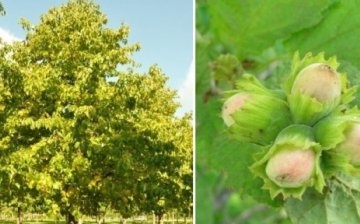The hazel in the photo is a tough nut to crack
Hazel grows in the European part of Russia in deciduous and coniferous-deciduous forests, forest-steppe, steppe zone along ravines. The hazel in the photo is not only delicious nuts, it is very beautiful during the spring flowering period.
The hazel in the photo is a large shrub up to 7 meters high with oval or rounded pubescent leaves, male and female flowers and fruits in the form of single-seeded nuts with a dense shell.
Hazel blooms in March, forming inflorescences in the previous growing season. The wind carries the pollen. The main ripening of fruits occurs in August-September, sometimes at the end of July. Harvest years alternate with lean ones. Nuts sprout well, usually sprouting next spring. Hazel grown from nuts begins to bear fruit at about 5-7 years and lives up to 60-80 years. In the wild, reproduction occurs mainly in a vegetative way: by shoots on a stump or by root suckers.
Hazel prefers humus-rich, calcareous, moderately moist loam and sandy loam. Leaves rich in calcium salts, after falling off, increase soil fertility. With prolonged severe frosts, it freezes.
Hazel is credited with the magical property of detecting objects hidden from view. In pagan times, white hazel wands served as a symbol for Druids, indicating their class, the ability to be an orator. In the time of the Vikings, hazel stakes were used to outline the "hazel field" that served for the agreed battles. He defined a kind of magic trait. In hostilities, hazel was used as a magical protection.



